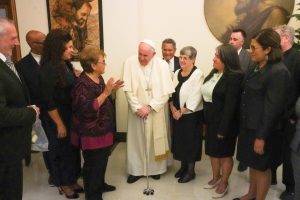Are Catholic colleges and universities worth the price of admission?
As almost all college students and their parents can tell you, paying for college hurts. For Jan VonHandorf, a sense of dread re-emerged in the summer after her son Dusty completed his first year at the University of Notre Dame. “In August $18,000 was due, and I had no idea how we would pay for it,” she recalls. Dusty was back home working a summer job in Villa Hills, Kentucky, and on one of his days off he accompanied his mom to a church festival in nearby Cincinnati. They bought tickets to the raffle and, in what seemed like an answer to her prayers, won $25,000. “Every cent went to Notre Dame,” she says.
Not everyone can count on financial aid via divine intervention, and even for the middle-income VonHandorf family the windfall didn’t cover more than sophomore year. “We really went semester by semester to send him to school,” she says. Dusty, who graduated in 2007, took out student loans, received some grants, paid for a semester with inheritance money, and worked 10 to 20 hours a week during the school year and full time during the summers. “In the end it was really a patchwork of financing,” said VonHandorf.
College costs have skyrocketed over the last two decades, and for students considering Catholic colleges and universities, the sticker price is sometimes two or three—or many more—times that of a state school. Compare Fordham University’s yearly tuition of $32,354 to State University of New York Binghamton’s $5,998 for in-state students, and it’s easy to see why students and parents might take one look at the price tags of these two New York schools—both listed as “more selective” national universities in U.S. News and World Report’s rankings—and be swayed toward the latter.
The reality is that the vast majority of Catholic students in college—nine out of 10, according to the Center for Applied Research in the Apostolate—attend public or non-Catholic private institutions, so outreach through Newman Centers, local parishes, and Catholic studies programs is essential. But Catholic colleges aren’t just for students from wealthy families, and they serve an essential and particular role for the church in the United States.
“The commodification of higher education is scary,” says Rosalie Mirenda, president of Neumann College, a Catholic college in Aston, Pennsylvania. “We at Neumann want to be Catholic. The Catholic, and in our case Franciscan, perspective that we bring to our world through our programs, our graduates, and all that we do is extremely important. We’re very serious about maintaining that Catholic imagination and our particular values. If we weren’t, then why not go to Penn State? They have wonderful programs from a secular point of view and it’s cheaper. Then the whole issue of financing goes away.”
But the issue of financing a Catholic college education wasn’t always quite as challenging as it is now. In 1974 Dusty VonHandorf’s father, Bob, graduated from Thomas More College, a diocesan school in Crestview Hills, Kentucky. Having worked his way through college, it was hard to appreciate that his son couldn’t just do the same. But while the cost per credit hour for the elder VonHandorf was just $38 in his senior year, Dusty’s was $1,370.
Past generations seem to have countless stories of first-generation students paying their own way, as well as stories of how the good Jesuits, Sisters of Mercy, Dominicans, and Christian Brothers “just made it work” for students whose families weren’t able to cover expenses.
But even then, the mission of Catholic colleges wasn’t to provide charity, says Richard A. Yanikoski, president of the Association of Catholic Colleges and Universities (ACCU). “They were founded to train priests and to provide a safe haven from the rampant Protestantism and secularism in other private institutions and state schools. Catholic schools were founded to educate Catholics, period.”
But as U.S. Catholics have climbed the socioeconomic ladder, Catholic colleges and universities have also become more competitive, more expensive, and can seem out of reach for students who don’t come from wealthy families.
Doing the numbers
According to the U.S. Department of Education, average annual tuition at four-year Catholic colleges and universities in 1980 was $2,738, and in 2006 it was $19,376. Even when adjusted for inflation, the 1980 cost in 2006 dollars is a mere $6,700. What accounts for the difference?
One factor—at all schools, not just Catholic ones—is increased interest in majors like business, computer science, engineering, biological sciences, and health professions. These programs have far higher costs than traditional arts and sciences majors. “Schools better have the very latest in technology because otherwise they’re training people for yesterday’s jobs,” says Yanikoski.
Recruiting faculty in these fields is also tough, he says: “Try to find a Ph.D. in finance who wants to teach when he or she can make 10 times more at a financial institution.” Nurses, too, especially those with advanced degrees, can make far more in a clinical setting than in higher education.
A second factor that influences pricing is that college amenities need to meet the ever-increasing expectations of students and parents, who are likely judging St. Mary’s and State U by the same standard. “Students don’t want to live in dorms; they want to live in apartments,” says Yanikoski. “They want Wi-Fi in their rooms. They want a parking garage close to the buildings, not on the edge of campus. And no one wants to be in the kind of classrooms I was educated in, with a flat floor and stationary desks and a chalkboard in front.”
Classrooms now need to be “smart,” with Internet access and video projection. Applicants consider the state of science labs, computer technology, and athletic facilities before making their final decision—particularly the athletic facilities, says Yanikoski. “They’re five times the size of previous ones, and they have coffee shops and workout facilities that would make the NFL drool.”
The good news, however, is schools try to soften the impact of these costs on students. Donors provide substantial funding for building and renovation projects, Yanikoski says, and schools cut costs by outsourcing, employing student workers, and participating in consortiums with other institutions to get the best prices on everything from paper to cleaning supplies. College presidents now spend at least half their time raising money, often for financial aid.
Balancing budgets
Statistics show that Catholic colleges and universities in particular have a strong commitment to financial aid. The U.S. Department of Education reports that nearly 80 percent of students at all religiously affiliated colleges receive institutional grants compared to just 32 percent of students at state schools. The average amount of institutional grant aid from Catholic colleges is notable: $8,446, compared to $6,451 at other religious colleges and $2,858 at public colleges.
In the past few years, schools such as Harvard, Stanford, and Yale made news by eliminating or heavily discounting tuition for students from middle-class families. But Harvard’s endowment of $34.6 billion, Yale’s $22.5 billion, and Stanford’s $17.1 billion make those deals possible. Most Catholic universities’ endowments are a tiny fraction of what the big three have stashed away.
Even Santa Clara University, with an endowment of $697.8 million, determined it couldn’t cover the $8 million a year it would cost to replace loans with grants for all students whose families earn under $60,000, according to a February Los Angeles Times story. That is a notable decision because Santa Clara’s endowment is fifth largest among Catholic colleges and universities, as documented by the 2007 Endowment Study by the National Association of College and University Business Officers, but still just 2 percent of Harvard’s fund.
But the financial aid developments at super-wealthy schools have spurred Catholic colleges to consider smaller but innovative approaches to keeping higher education affordable.
The College of the Holy Cross in Worcester, Massachusetts offers free tuition to city residents whose families earn less than $50,000 a year, and John Carroll University in University Heights, Ohio allows families making under $40,000 to enroll their incoming freshman tuition-free (university scholarship and grant aid is available in subsequent years).
Other approaches to rein in costs have also emerged, according to the National Association of Independent Colleges and Universities (NAICU), and they’re ones that appeal to families with higher (but not high) incomes. Gannon University, a diocesan school in Erie, Pennsylvania, has a dual enrollment program with area high schools that allows 11th and 12th graders to take college courses at a discounted price and earn college credit. The College of Notre Dame of Maryland in Baltimore guarantees a scholarship of at least $7,000 to transfer students (often from community colleges) who have a 3.2 grade point average.
Both schools also offer accelerated degree programs (as do a handful of other Catholic colleges) that, by virtue of their compressed schedules, save students on tuition and room and board costs. At least two Catholic universities—Regis in Denver and Dominican in San Rafael, California—pledge that students who follow university guidelines and stay on track will graduate in four years, or the remainder of their classes are free. Perhaps most notable, Lourdes College in Sylvania, Ohio actually cut tuition by 41 percent in 2004.
Still, students and their parents need to be savvy financiers when it comes to college. The U.S. Department of Education reports that the average student loan amount borrowed by students at Catholic colleges and universities in 2005-06 was $4,599.32. Assuming four years of loans and a 6.8 percent interest rate for federal Stafford loans, that means the average graduate will owe $18,396, which he’ll pay back at $211.70 a month over 10 years.
Of course, many students will owe much, much more. If a student borrows $7,750 a year in Stafford loans for four years, she’ll be paying back $356.75 a month over 10 years. The website FinAid.org estimates that she’ll need an annual income of $42,810 to afford those loans—a stretch for many recent college graduates in their first jobs. Additionally, many students and families rely on private loans as well as federal student loans, and those come with steeper fees and interest rates that are tied to the borrower’s credit score.
Students taking charge
After John Houser was accepted to Xavier University in Cincinnati, he set up an interview to see what kind of aid he could receive. Houser’s parents had told him and his three younger sisters well before the college application process that they would pay for tuition at their local state school, Indiana University-Purdue University Fort Wayne, or the equivalent at any other school, and it was the student’s responsibility to cover the rest. Houser ended up getting a half-tuition merit scholarship to Xavier, a few small outside scholarships, and qualified for the Federal Work-Study program.
Still “with tuition going up every year there was always a question of how I could pay for it.” Houser covered his room and board sophomore year by working as a resident assistant and worked at another job for 10 hours a week during the school year, increasing to full time during his breaks.
Financial aid was also a key concern for Katie Sullivan. As the sixth of seven children to attend college, she knew that her parents’ budget was already stretched thin. “I tried really hard to do it all myself,” says Sullivan, who graduated from the University of San Diego in 2005 but remembers how her parents gave her money for books and plane tickets and how, whenever they came to visit, “they’d buy me lots of food.” They also provided plenty of financial guidance and moral support.
Sullivan, who grew up in Littleton, Colorado, applied to about eight schools, including Georgetown, Santa Clara, Loyola Maryland, and Notre Dame, and was accepted everywhere. “I remember sitting down with my parents and looking at the financial aid offers,” she says. During their financial summit it became clear that USD, with its $10,000 Trustee Scholarship award, would be the most affordable—even more than the University of Colorado with in-state tuition.
Opening classroom doors
Sullivan and Houser’s stories are encouraging but they also represent a reality of higher education: “The bulk of aid goes to merit, not need,” says Father Dennis Holtschneider, president of DePaul University in Chicago, the country’s largest Catholic university. Sullivan and Houser had financial need, but they were also exceptional students.
“Catholic colleges and universities are becoming more and more similar to other colleges in the United States, and the national trend for all universities is to throw their financial aid to the top SAT scores,” says Holtschneider. A Vincentian priest, Holtschneider is reminded of the priority his order and school places on serving the poor whenever he walks into his office and sees St. Vincent de Paul’s name over the door. According to the university 38 percent of DePaul students are the first in their families to attend college.
Still, Holtschneider recognizes that by emphasizing need-based aid, some rankings are negatively affected. It’s a hit he’s willing to take: “We at Catholic universities need to hold the line on need-based aid.”
The encouraging news is that DePaul is in good company with other Catholic schools in its efforts to be accessible to students who aren’t rich. St. Mary’s College of California, with its picturesque campus in the rolling hills of the East Bay town of Moraga, recruits students who attended the San Miguel schools (a network of middle schools that educate inner-city, low-income students). According to Brother Ronald Gallagher, St. Mary’s president, the school aims to have 25 percent of its students come from families that make less than $40,000. “In our mission we want to make sure to reach the underserved.”
At Mount Saint Mary’s College, a women’s college in Los Angeles, the student body mirrors the ethnic diversity of its city: Forty-eight percent of the undergraduate students are Latina, 22 percent are Asian, 11 percent are African American, and 15 percent are white. Many are daughters of immigrants or immigrants themselves. About 40 percent of students are first-generation college students.
“Every capable and motivated young woman, regardless of income, should have an opportunity to pursue higher education, and at a Catholic college if they so choose,” says President Jacqueline Powers Doud. “Our big challenge is to provide financial aid.” Support services, too, are a crucial part of the mix: “A lot of underrepresented students get into college but they don’t get out. We’re very aware of this here, and we have very good persistence rates.”
Of course, no school can afford to enroll only low-income students, and no school attracts only well-off students who pay full tuition. But with more than 200 Catholic institutions of higher education in the United States, including everything from reasonably priced two-year institutions to academically rigorous and costly doctoral-level ones, there are increased opportunities for students wanting to pursue Catholic higher education. “Whatever you want you can find it, and in five or ten places,” says ACCU’s Yanikoski.
Even with this diversity of options, the financial bite of college still stings middle-income families. A key reason is that over the past 30 years, the federal government has provided less and less need-based aid per student. “It has a backward effect on tuition prices,” says Yanikoski. “Families that can afford it are paying a larger percentage of the true cost.”
Great expectations
Lauren Woessner of Wrentham, Massachusetts knew she wanted a small, highly ranked school that was close to home, and College of the Holy Cross fit those requirements—plus, it just “felt right.” Her parents covered her first year, and after that, college expenses were up to her. Woessner received federal loans, Federal Work-Study, a small grant, and ended up taking out private loans to cover costs.
Woessner had planned to go on to law school, which might have enabled her to make short work of those loans, but at Holy Cross she discovered another passion. Now in her final year in the Master of Social Work program at the University of California at Berkeley (from which she expects to graduate nearly debt-free) and expecting to work in the field of community mental health, she’s bracing herself for the upcoming struggle to make the minimum monthly payments—which will be hundreds of dollars—for her undergraduate education.
“I don’t regret it at all because I had such a good experience at Holy Cross,” says Woessner, who graduated in 2005. “I got a good education, made lifelong friends, developed my faith, and my future looks very different from what I would have expected elsewhere.”
Houser, who graduated from Xavier in 2005, is also now in graduate school, working on a Ph.D. in school psychology at Indiana University. “I came to I.U. because it was in-state and I could afford it,” he says, “but when I got here I was struck by how the language was different. I wanted to help kids with severe emotional and behavioral disabilities because they are the neediest in the schools, and it seemed like the way my abilities best intersected with the world’s needs. But I had to adjust the way I spoke because there wasn’t that underlying current of Catholic social teaching that was at Xavier. The concept of social justice is here, but it’s framed in a very secular way.”
Sullivan is currently working in campus ministry at Marist College, a once-Catholic but now non-religious private school in Poughkeepsie, New York. “If you had told me my freshman year what I’d be doing now, I would have laughed,” she says, remembering her pre-college thoughts of teaching high school. Her plans changed after three years of participating in and leading retreats, alternative spring break trips, and helping with other campus ministry programs at USD. “I thought, ‘I could do campus ministry. This could be very life-giving.’ ”
VonHandorf, who graduated from Notre Dame with a computer science degree, also found a different path. Volunteering as a lector and eucharistic minister at Notre Dame’s Basilica of the Sacred Heart turned into coordinating weekend liturgies, and spiritual direction helped him make the decision at the end of his junior year to join the Congregation of the Holy Cross as a candidate for the priesthood. “I was admitted shortly after Easter and have been enjoying my time ever since,” he says. He’s now in his novitiate year with the order.
It’s less likely he would have found that path at a non-Catholic school, but that’s just one of many reasons why Jan VonHandorf feels so strongly about making Catholic higher education available for students who want to pursue it, regardless of their economic means.
“We always counseled our kids to find the school where they thought they’d fit the best,” she says. “I’ve heard the argument from many parents that ‘you can go anywhere to get your reading and history and math.’ But when students do that, they miss the atmosphere in which the learning takes place. What are the values driving the mission of the university? What’s the climate on campus? These factors are just as important.
For more:
College finance 101
This article appeared in the November 2008 issue of U.S. Catholic (pgs 22-25), Volume 73; Number 11.














Add comment